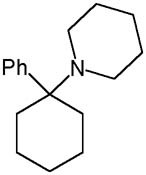 Ketamine
Ketamine
Ketamine, a phencyclidine derivative, is arguably our most ideal anesthetic agent!
History
1958: phencyclidine (phenyl cyclohexyl piperidine, PCP) introduced into clinical anesthesia * Phencyclidine produced an unacceptably high incidence of hallucinations, confusion and delirium, so its development for use in human anesthesia was discontinued. It became commercially available for use as a veterinary anesthetic in the 1960s under the trade name of Sernylan and was placed in Schedule III under the U.S. Federal Contolled Substances Act (CSA).
In 1978, due to considerable abuse phencyclidine was transferred to Schedule II under the CSA and manufacturing of Sernylan was discontinued. Today, virtually all of the
phencyclidine encountered on the illicit market in the U.S. is produced in clandestine
laboratories.
Phencyclidine produced an unacceptably high incidence of hallucinations, confusion and delirium, so its development for use in human anesthesia was discontinued. It became commercially available for use as a veterinary anesthetic in the 1960s under the trade name of Sernylan and was placed in Schedule III under the U.S. Federal Contolled Substances Act (CSA).
In 1978, due to considerable abuse phencyclidine was transferred to Schedule II under the CSA and manufacturing of Sernylan was discontinued. Today, virtually all of the
phencyclidine encountered on the illicit market in the U.S. is produced in clandestine
laboratories.1959: cyclohexamine tried *
1962: ketamine (Ketalar) synthesized by Stevens
1965: ketamine tried in humans *
1970: ketamine officially released for clinical use in U.S.
1999: ketamine becomes a schedule III substance under the CSA